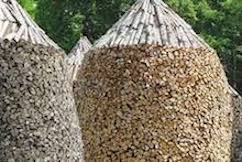
Chopping, Stacking and Drying Wood the Scandinavian Way

Lars Mytting, MacLehose Press, London
An unexpected Christmas gift from my children, this book was inspired by the author watching the transformation wrought in an elderly neighbour through the process of sorting, chopping and stacking wood for the following winter. Having just witnessed the warmest December of my life in England, with average temperatures of around 12 degrees Celsius, it is sometimes difficult to remember that there are still many places such as Norway and Sweden where having a good supply of dried firewood for the winter is the difference between life and death.
The reader is taken on a journey from the cultivation of trees (including coppicing to generate rapid re-growth from tree stumps) to the tools required for cutting trees and splitting logs, on to the stacking of logs to enable the wood to dry, culminating with the process of burning. Mytting has managed to produce a very rare book – one which is partly an instruction manual, partly a historic account of the use of wood through the centuries and partly a scientific presentation on the process of wood drying and bioenergetics research which is accompanied throughout by a deep feeling for the subject and valuation of our connection to and reliance on this living material.
There are some truly surprising facts which are presented, including how pine trees which suffer axe cuts produce oil that bathes and protects the wound, how the best time to cut trees in order to minimise the sap content is determined by the lunar cycle, and that willow trees were the original natural source of salicylic acid – the active ingredient of aspirin. There are also a number of more humorous observations. My favourites are the Norwegian term for the loss of heat through the use of conventional fireplaces with long chimneys – “heating for the crows”, and the insights into peoples’ characters that are afforded by the size and shape of their woodpiles.
The writing is complemented by some lively photographs of some of the woodsman that Mytting spent time with and some extraordinary woodpiles. Some of these, built very carefully to avoid collapse, become accidental art works of great beauty because of their precision and shape.
As someone who over the past twenty years has often found a particular contentment whilst splitting logs, I was very touched by a quotation from Hans Borli in this book:
“If you are master of the art of setting your gear up properly then there is a special joy in seeing the way that sharp steel eats its way through the logs. The smell of resin and fresh wood, the sight of the smooth, clean cut made by a newly sharpened axe blade – such things can fill a man with a wordless joy and put him in touch with the essential joy of all physical labour; in his own hands he weighs the feel of life itself.”
Now it’s time to go and build a fire.
Geoff Butts